Entrenchment Tools of the French Infantry
At the turn of the 20th century, the entrenching tool had truly come into its own as an essential item of the soldier’s kit. For much of modern military history, entrenching was a task assigned to special pioneer and engineer units and as such, the individual infantry rifleman was not provided with the traditional shovel, pick, or saw. With the increased range, accuracy and rate of fire, it became critical that soldiers have the ability to quickly entrench in place. With the advent of trench warfare in the fall of 1914, the entrenchment tool proved invaluable. Indeed in a sense, it became just as important as the soldiers rifle, primarily as a means of self-preservation. Aside from this first function, entrenching tools (particularly the spade) were also put to use in trench raids as fighting weapons.
Each infantryman received an outil portative (“portable tool”) with distribution being done on the company level. In 1914, these consisted of the following:
- Pelle-bêche (“Spade-shovel“), M1879
- Pelle-pioche (“Pick-shovel”), M1909
- Pioche (“Pickaxe”), M1909
- Cisailles à main (“Hand Wire-cutters”), M1905
- Hache à main (“Hand Hatchet”)
- Serpe (“Billhook”)
- Scie articulée (“Articulated saw”), M1879
By 1916, the above tools would be supplemented by the Cisailles M1915, Pelle (ronde) M1916, and Pioche M1916.
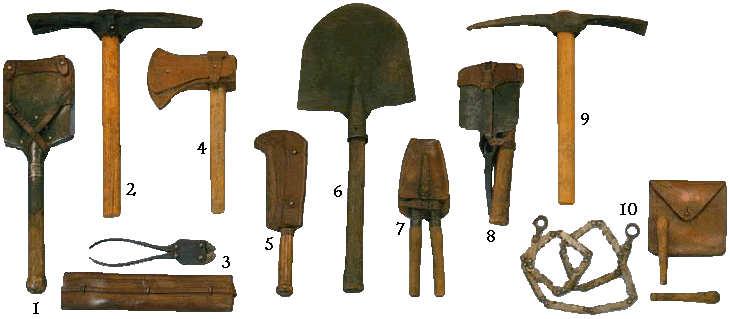
1. Pelle-bêche, M1879
2. Pioche, M1909
3. Cisailles, M1905
4. Hache à main
5. Serpe
6. Pelle (ronde) M1916
7. Cisailles, M1915
8. Pelle-pioche, M1909
9. Pioche portative, M1916
10. Scie articulée, M1879
Each tool was intended to serve a specific purpose, which was laid out in a 1903 manual:
Pelle-bêche (“Spade-shovel“): in theory, one lateral edge is serrated for cutting, the other is filed down for chopping, with the lower edge sharpened for digging (spade). Employed to assist in the construction of revetments.
Pioche portative (“Portable Pick-axe”): employed as a tool of destruction to cut down walls, pierce loop-holes, etc.
Hache à main (“Hand Hatchet”): employed for to aid in bivouacking, construct abatis, destroy obstacles such as palisades, barriers, doors, etc.
Scie articulée (“Articulated saw”): employed to cut trees and telegraph poles. It is ordinarily operated by two men but can also be operated by four with two holding either handle while two others assisting by means of cords attached to the handles.
Serpe (“Billhook”): employed for pruning and sharpening branches for abatis, removing brush, preparing wood for making stakes, fascines, wattling, etc., and for various bivouacking purposes.
While there were regulations on the designs of the cases, there design variations from manufacturer to manufacturer. Yet every entrenchment tool aside from the M1916 pioche and pelle ronde were carried in a case on the pack and, when necessary, on the soldier's belt. For information on how each entrenchment tool was carried on the soldier's pack, see the Knapsack page.
Instructions on how to carry each tool on the belt:
Pelle-bêche (“Spade-shovel“): placed on the right side, the belt passing through the case belt-loops, the concave side of the shovel blade facing in.
Pelle-pioche (“Pick-shovel”): placed on the right side, the belt passing between the gap formed by the body and the small case strap above the belt-loop on the case, the concave side of the shovel blade facing in, the pick iron pointing downward to the ground.
Pioche portative (“Portable Pick-axe”): placed on the right side, the belt passing through the case belt-loop, the handle below the iron. Alternatively, on the right side, the handle can be placed between the body and the belt, with the iron resting between the top edge of the belt.
Pic à tête (“Pick”): placed on the right side, the belt passing through the case belt-loop, the handle below the iron. Alternatively, on the right side, the handle can be placed between the body and the belt, with the iron resting between the top edge of the belt.
Hache à main (“Hand Hatchet”): placed on the right side, the belt passing through the case belt-loop, the handle below the iron. Alternatively, on the right side, the handle can be placed between the body and the belt, with the iron resting between the top edge of the belt.
Hache portative (“Hand Hatchet”): placed on the right side, the belt passing through the case belt-loop, the handle below the iron. Alternatively, on the right side, the handle can be placed between the body and the belt, with the iron resting between the top edge of the belt.
Scie articulée (“Articulated saw”): attached to the belt in the same way as the cartridge pouch.
Cisaille (“Billhook”): placed on the right side, the belt passing through the case belt-loop, opening facing out, with the longest portion of the case facing down.
Serpe (“Billhook”): not to be carried on the belt.
Distribution Within a Company, August 1914
| Type of Tool |
1906 (Old) Assortment |
1909 (New) Assortment |
| Pelle-bêche ("Spade-shovel") |
112 |
80 (5 per squad) |
| Pioche ("Pickaxe") |
32 |
-- |
| Pelle-pioche ("Pick-shovel") |
-- |
80 (5 per squad) |
| Hache à main ("Hatchet") |
16 |
8 (2 per section, corporals) |
| Serpe ("Billhook") |
16 |
12 |
| Cisailles ("Wire-cutters") |
4 |
4 (1 per squad) |
| Scie articulée ("Articulated saw") |
1 |
1 |
| Total |
181 |
185 |
Distribution Within a Company, December 1916
 Pelle-bêche (M1879). Top: pre-war case (1880s) made of blackened leather (grain side out). The complicated design would lead to simplified models even before the war. Middle: this model (dated 1885) has a serrated (saw) edge per regulations, however, this stipulation seems to have gone largely ignored. The case is a simplified pre-war model adopted just before the war and produced in large quantities in 1914. Designed with a single belt loop, variants were also made with a double belt loop. Bottom: the war-time M1914 case (grain side in) made in natural brown leather.
Pelle-bêche (M1879). Top: pre-war case (1880s) made of blackened leather (grain side out). The complicated design would lead to simplified models even before the war. Middle: this model (dated 1885) has a serrated (saw) edge per regulations, however, this stipulation seems to have gone largely ignored. The case is a simplified pre-war model adopted just before the war and produced in large quantities in 1914. Designed with a single belt loop, variants were also made with a double belt loop. Bottom: the war-time M1914 case (grain side in) made in natural brown leather.
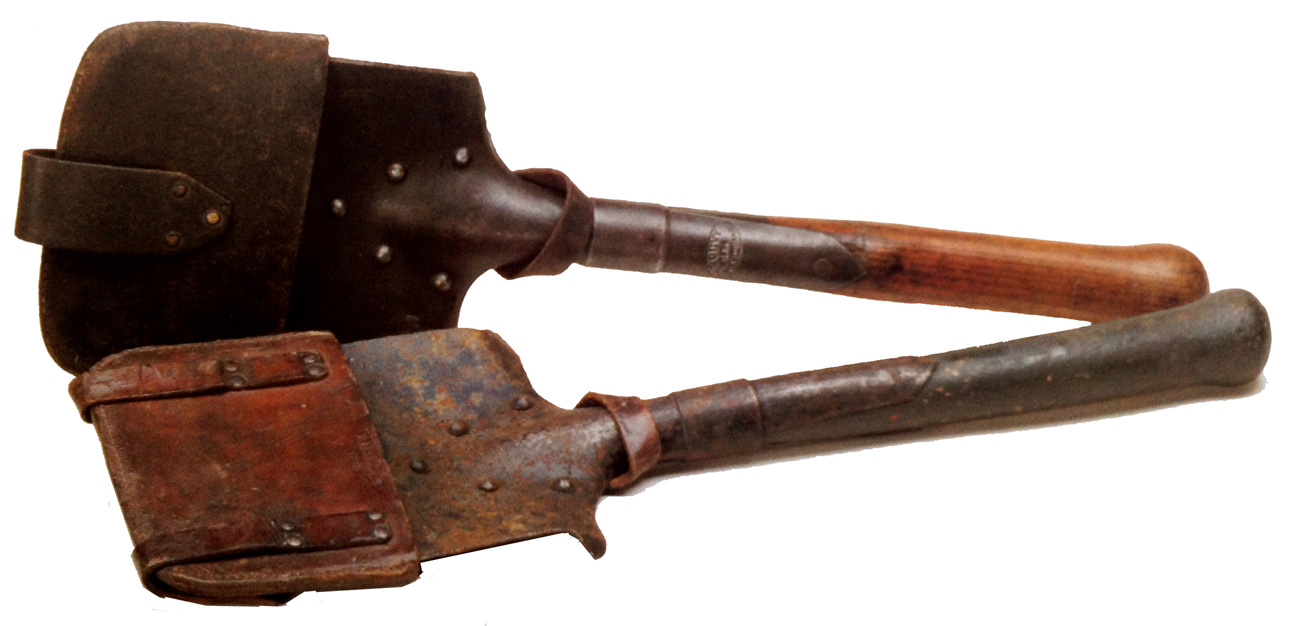 Pelle-bêche (M1879). Top: pre-war case in black leather and single-belt loop. Bottom: with M1914 riveted (economized) case in natural brown leather and double belt loop.
Pelle-bêche (M1879). Top: pre-war case in black leather and single-belt loop. Bottom: with M1914 riveted (economized) case in natural brown leather and double belt loop.
 Pelle ronde ("round shovel") M1916 with case. In principle, the case was reserved for shovels distributed in the engineers and was not distributed to infantry. Aside from being distributed with a shorter handle (45 cm in length), the M1916 was identical to the pre-war distributed to engineers.
Pelle ronde ("round shovel") M1916 with case. In principle, the case was reserved for shovels distributed in the engineers and was not distributed to infantry. Aside from being distributed with a shorter handle (45 cm in length), the M1916 was identical to the pre-war distributed to engineers.
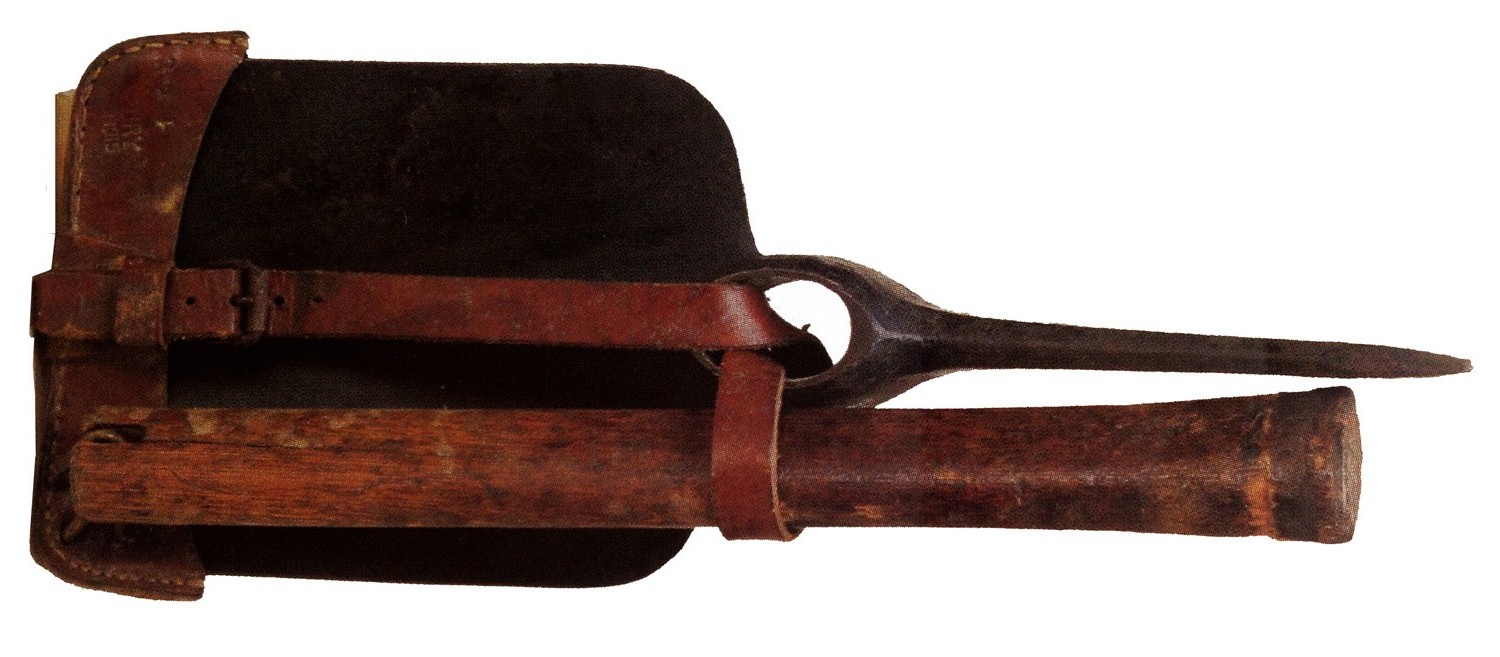 Pelle-pioche M1909 ("Seurre" pick-shovel after its inventor) with case. An iron hook secured the handle to the case. The example here however uses the old style (M1845) cartridge pouch hook instead. Despite it's well conceived design, more simplified cases were quickly produced in canvas, which were simple sacs that could hold the blade and handle together.
Pelle-pioche M1909 ("Seurre" pick-shovel after its inventor) with case. An iron hook secured the handle to the case. The example here however uses the old style (M1845) cartridge pouch hook instead. Despite it's well conceived design, more simplified cases were quickly produced in canvas, which were simple sacs that could hold the blade and handle together.
 The Pic à tête (“pick”) was equally distributed to the infantry in addition to the heavier pioche portative. The two pick-axes heads shown here are M1916s. Theoretically, the portable pick was not to be distributed to the infantry with a case.
The Pic à tête (“pick”) was equally distributed to the infantry in addition to the heavier pioche portative. The two pick-axes heads shown here are M1916s. Theoretically, the portable pick was not to be distributed to the infantry with a case.
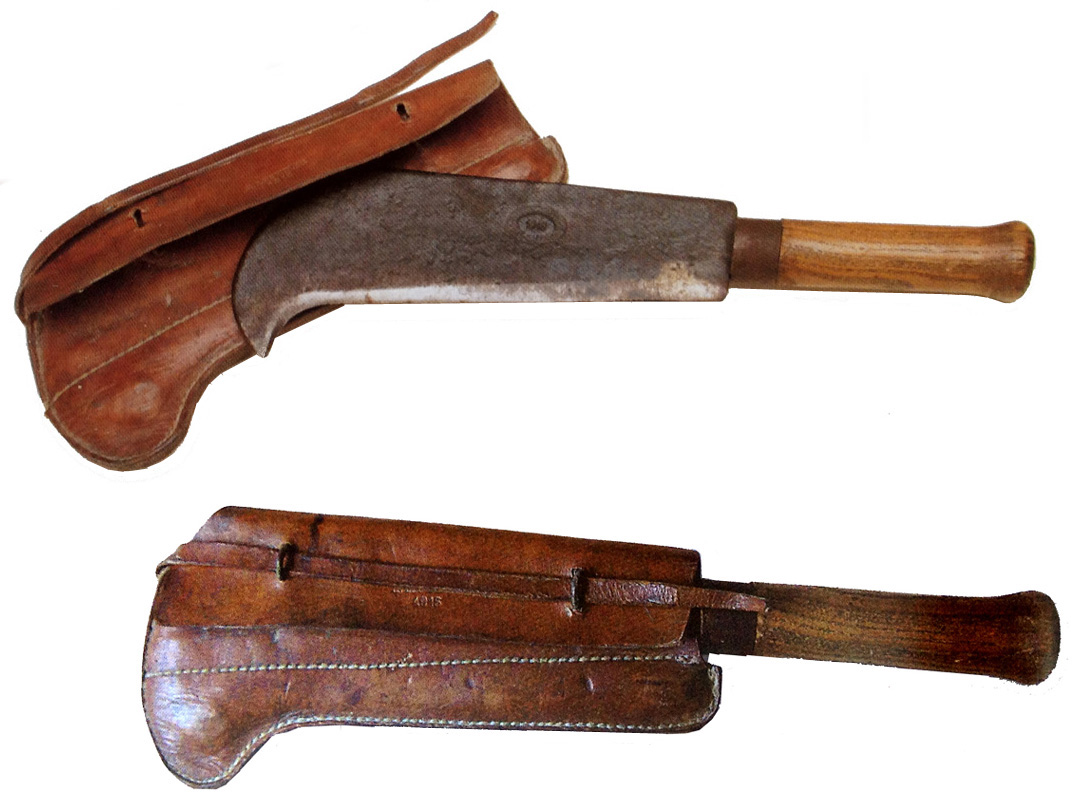 Serpe with case. The billhook was one of the only portable tools that could not be carried on the belt. The billhook was not pushed by authorities to be used as a weapon, at least not officially at any rate. Variants of cases were produced during the war.
Serpe with case. The billhook was one of the only portable tools that could not be carried on the belt. The billhook was not pushed by authorities to be used as a weapon, at least not officially at any rate. Variants of cases were produced during the war.
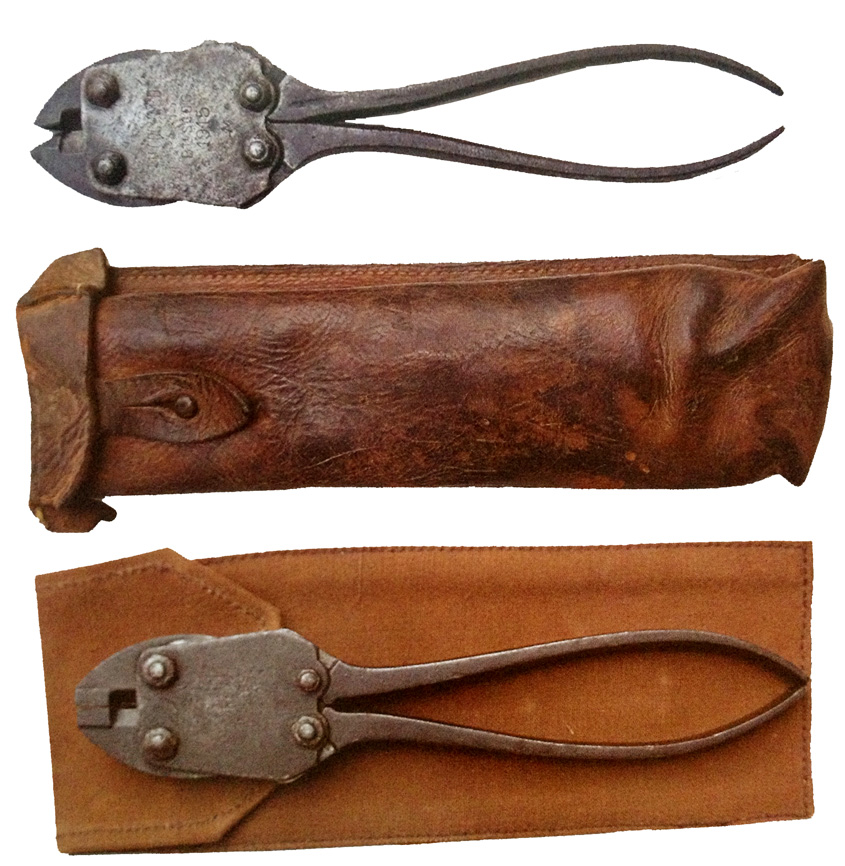 The cisailles M1905 with a war-time production leather case and an ersatz canvas pouch. The small size and light design of the M1905 quickly proved insufficient in the environment of trench warfare.
The cisailles M1905 with a war-time production leather case and an ersatz canvas pouch. The small size and light design of the M1905 quickly proved insufficient in the environment of trench warfare.
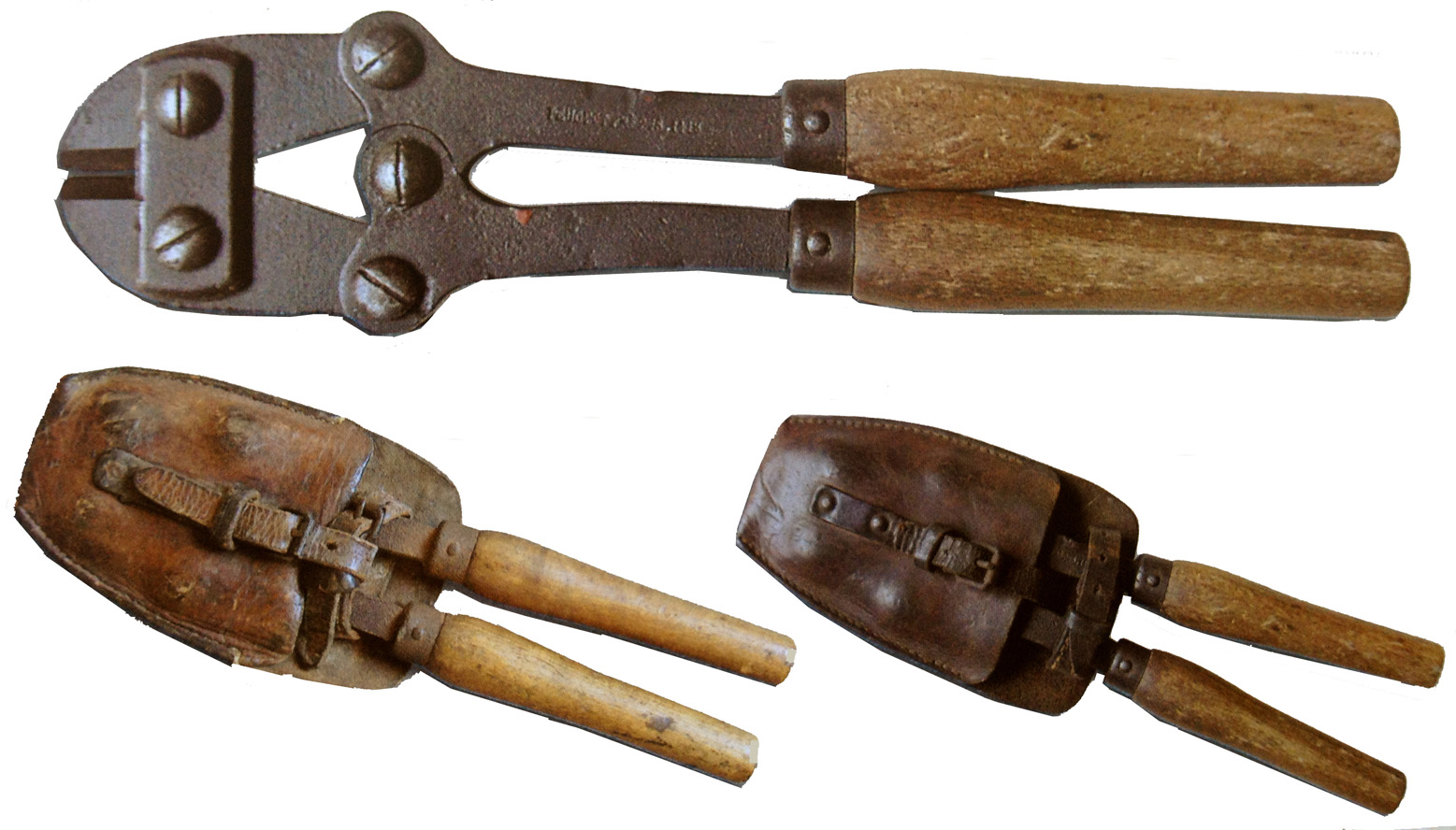 The cisailles M1915 ("Peugeot" after the maker) was a notable improvement upon the M1905. The first model case (bottom left) was not well-conceived and the later model (bottom right) was a more practical, simplified version.
The cisailles M1915 ("Peugeot" after the maker) was a notable improvement upon the M1905. The first model case (bottom left) was not well-conceived and the later model (bottom right) was a more practical, simplified version.
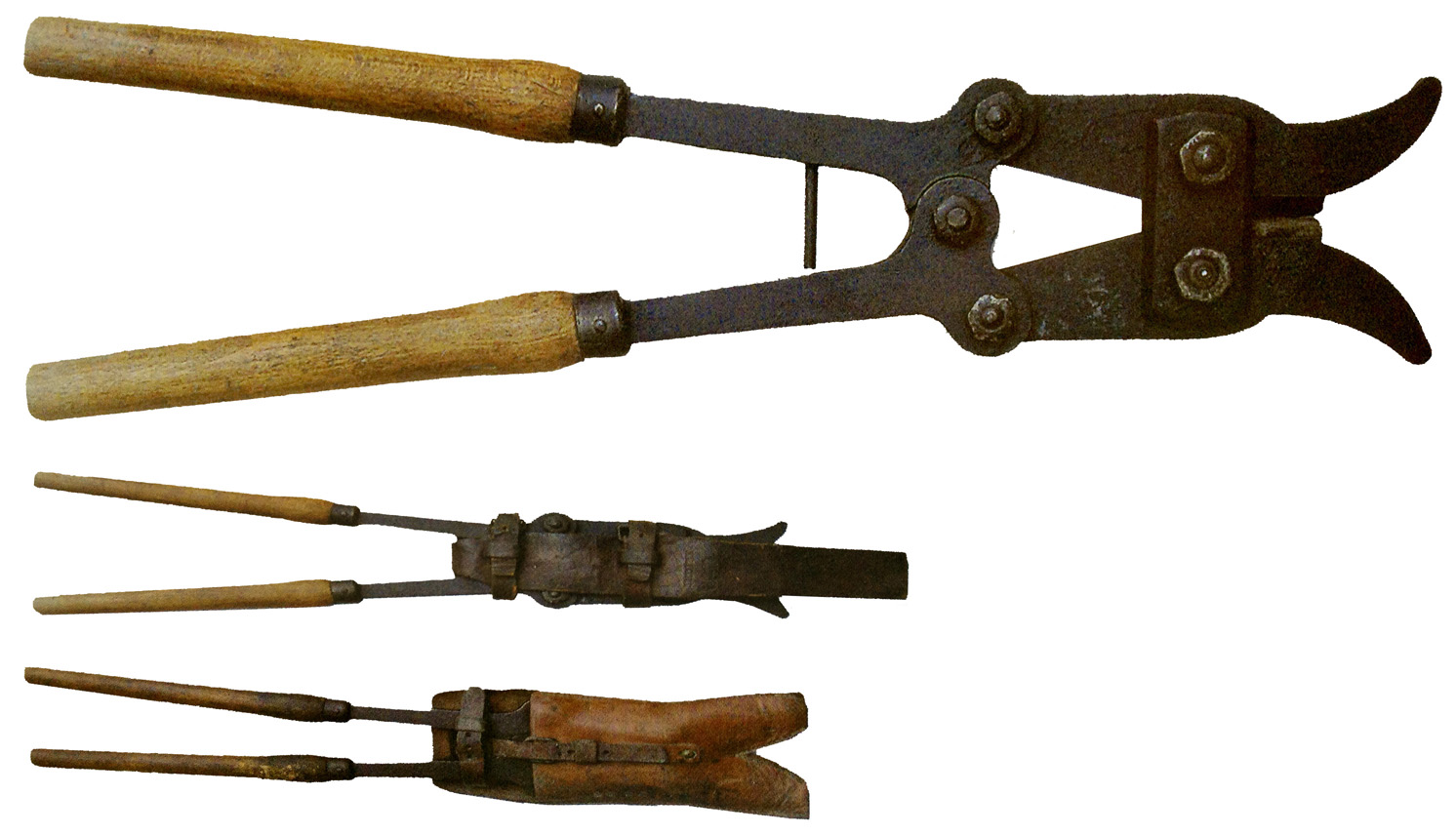 The Peugeot grandes cisailles was a modified version of the M1915 which first appeared in 1916. This example was equipped with "ears" that acted as wire catchers to facilitate snagging and cutting the strands. A version without these was also made. At the bottom are two types of cases for the large wire-cutters, the one on top being the most common.
The Peugeot grandes cisailles was a modified version of the M1915 which first appeared in 1916. This example was equipped with "ears" that acted as wire catchers to facilitate snagging and cutting the strands. A version without these was also made. At the bottom are two types of cases for the large wire-cutters, the one on top being the most common.
 Various models of cisailles including a war-time reinforced pair, a couple large Peugeot M1915s and an original M1915.
Various models of cisailles including a war-time reinforced pair, a couple large Peugeot M1915s and an original M1915.
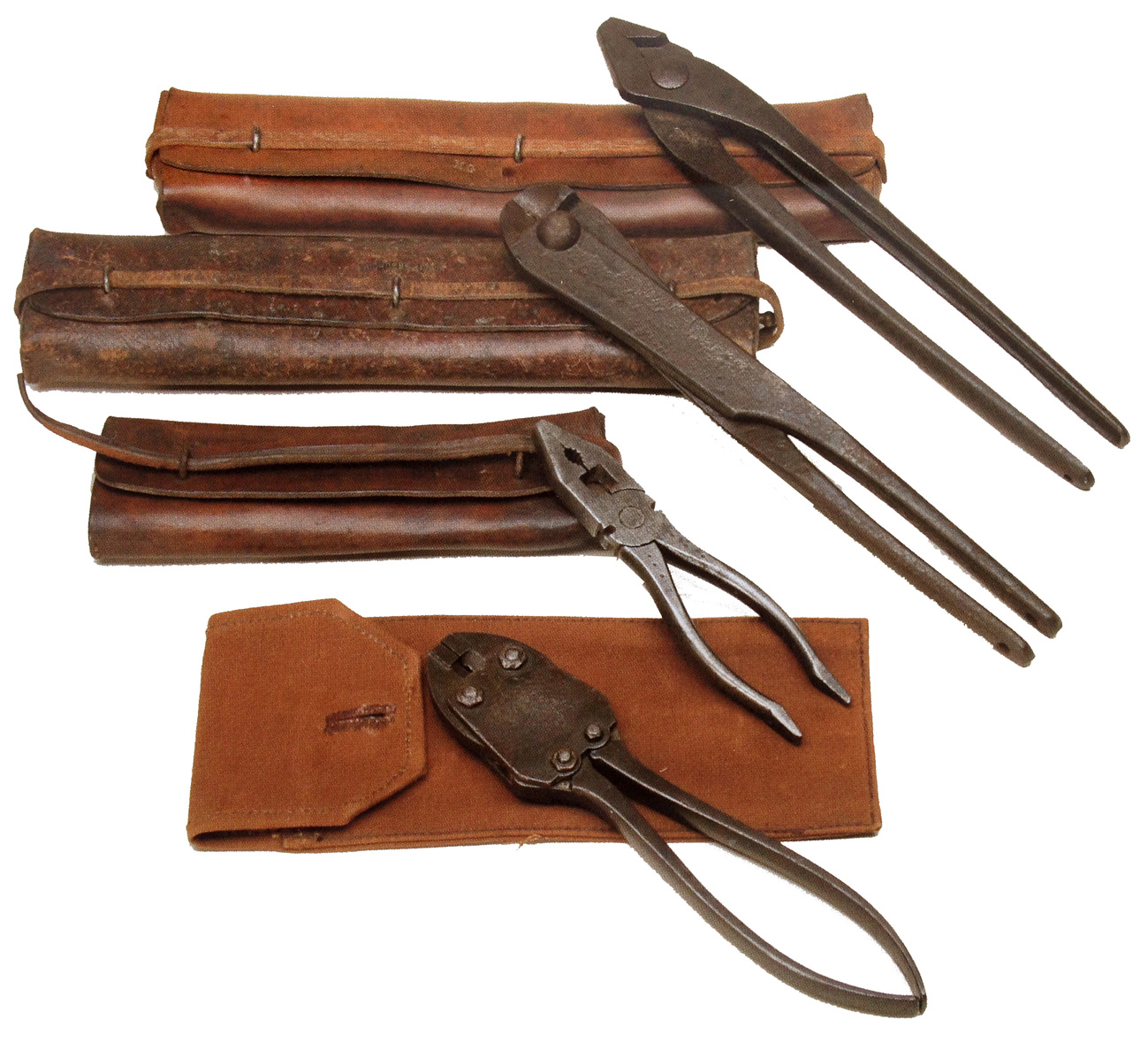 Various models of small cisailles à main produced during the war with leather and canvas carrying cases.
Various models of small cisailles à main produced during the war with leather and canvas carrying cases.
 Scie articulée M1879 (also referred to as the scie pliante) with regulation cases and an ersatz case (bottom-left). The case was intended to hold both the folding saw and the two wood removable handles. Proof of the tool's continued use is with this example that was produced in 1917.
Scie articulée M1879 (also referred to as the scie pliante) with regulation cases and an ersatz case (bottom-left). The case was intended to hold both the folding saw and the two wood removable handles. Proof of the tool's continued use is with this example that was produced in 1917.
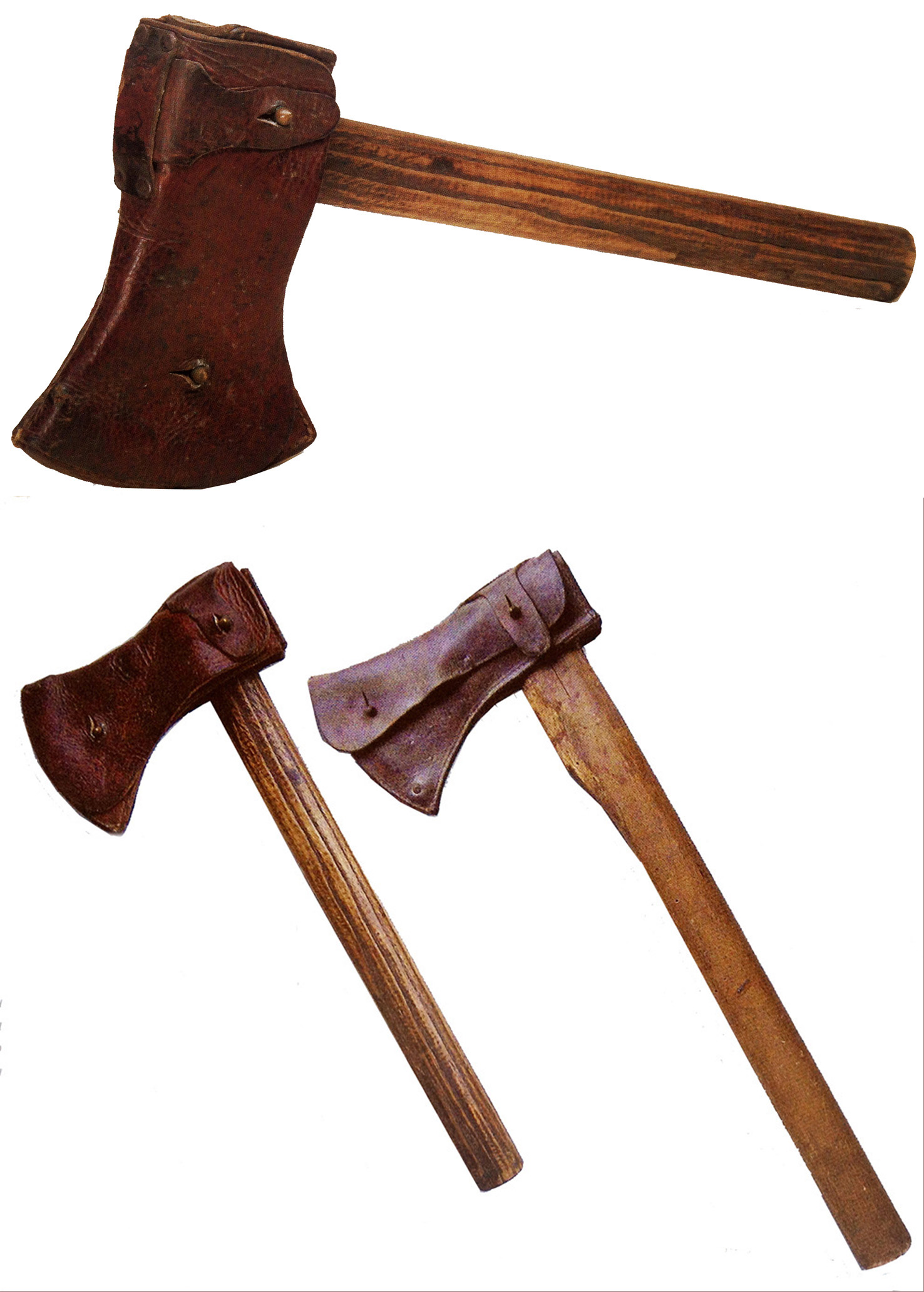 Top and bottom left: hache à main with case. At right: hache portative distributed to engineers was occasionally found in the infantry as well. In principle, for transport the handle is separated from the blade.
Top and bottom left: hache à main with case. At right: hache portative distributed to engineers was occasionally found in the infantry as well. In principle, for transport the handle is separated from the blade.
Spec drawings of portable and park (engineers) entrenchment tools taken from the Manuel du Chef de Section d'Infanterie dated January 1916 and the Instruction sur les travaux de campagne à l'usage des troupes de toutes armes dated 21 December 1915.
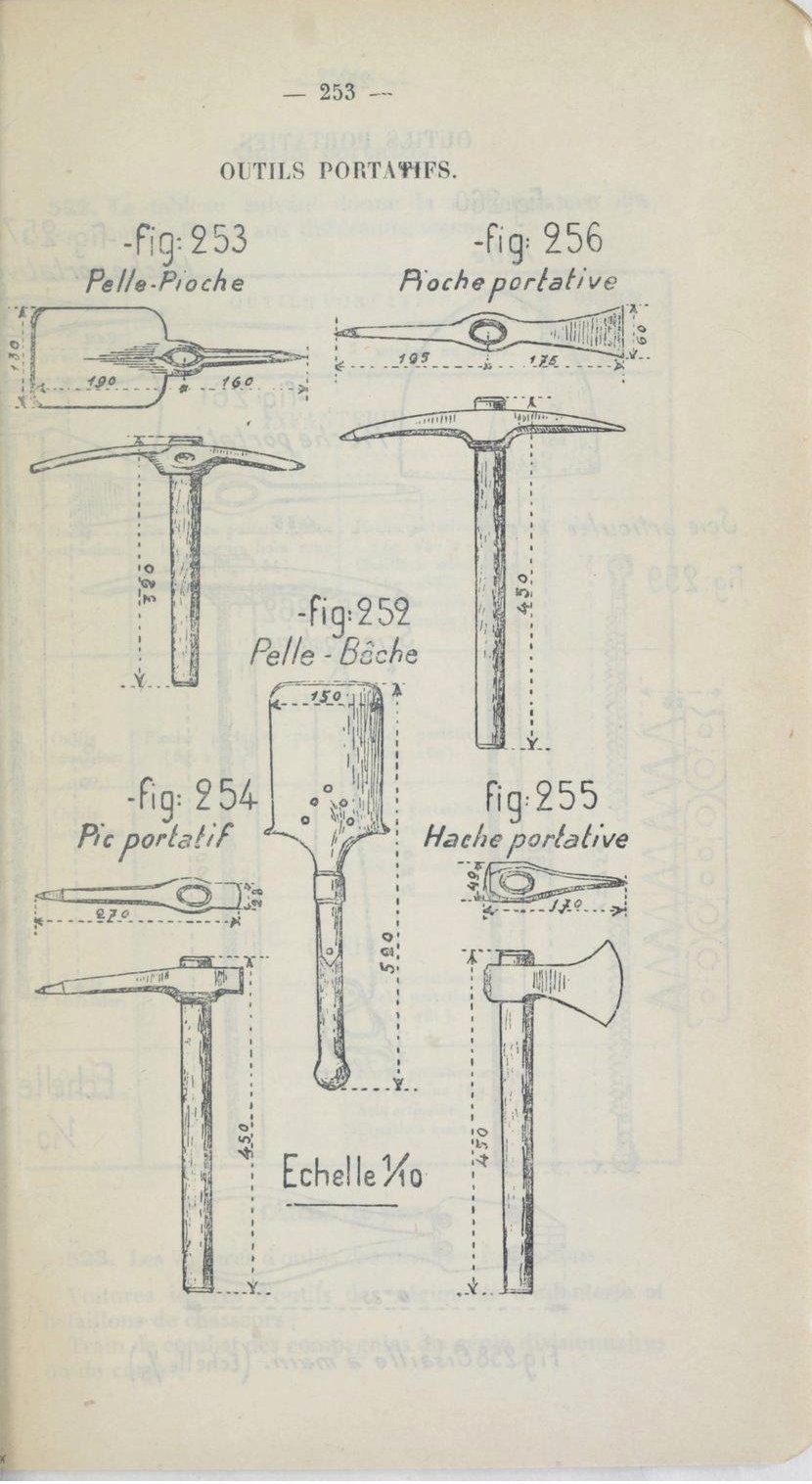

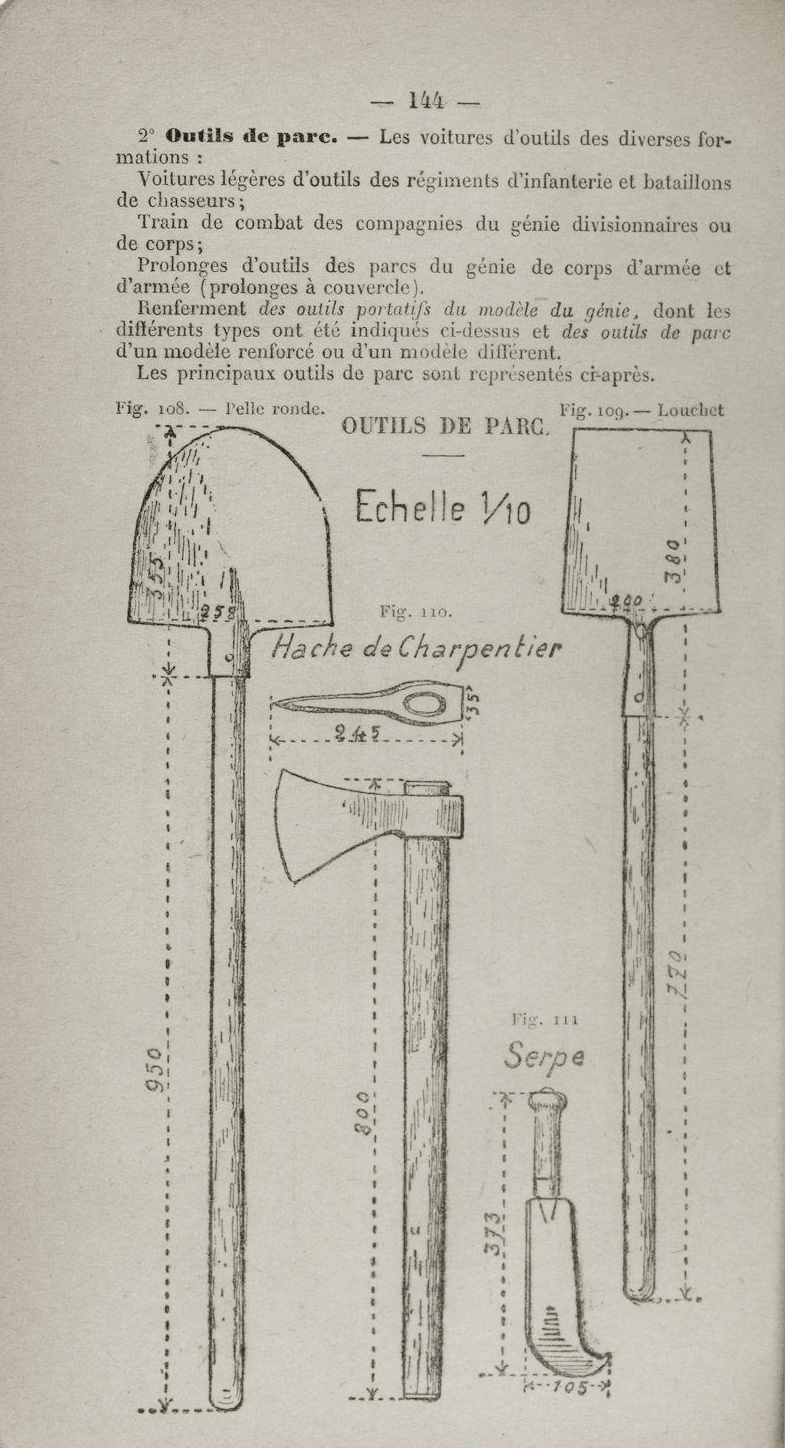
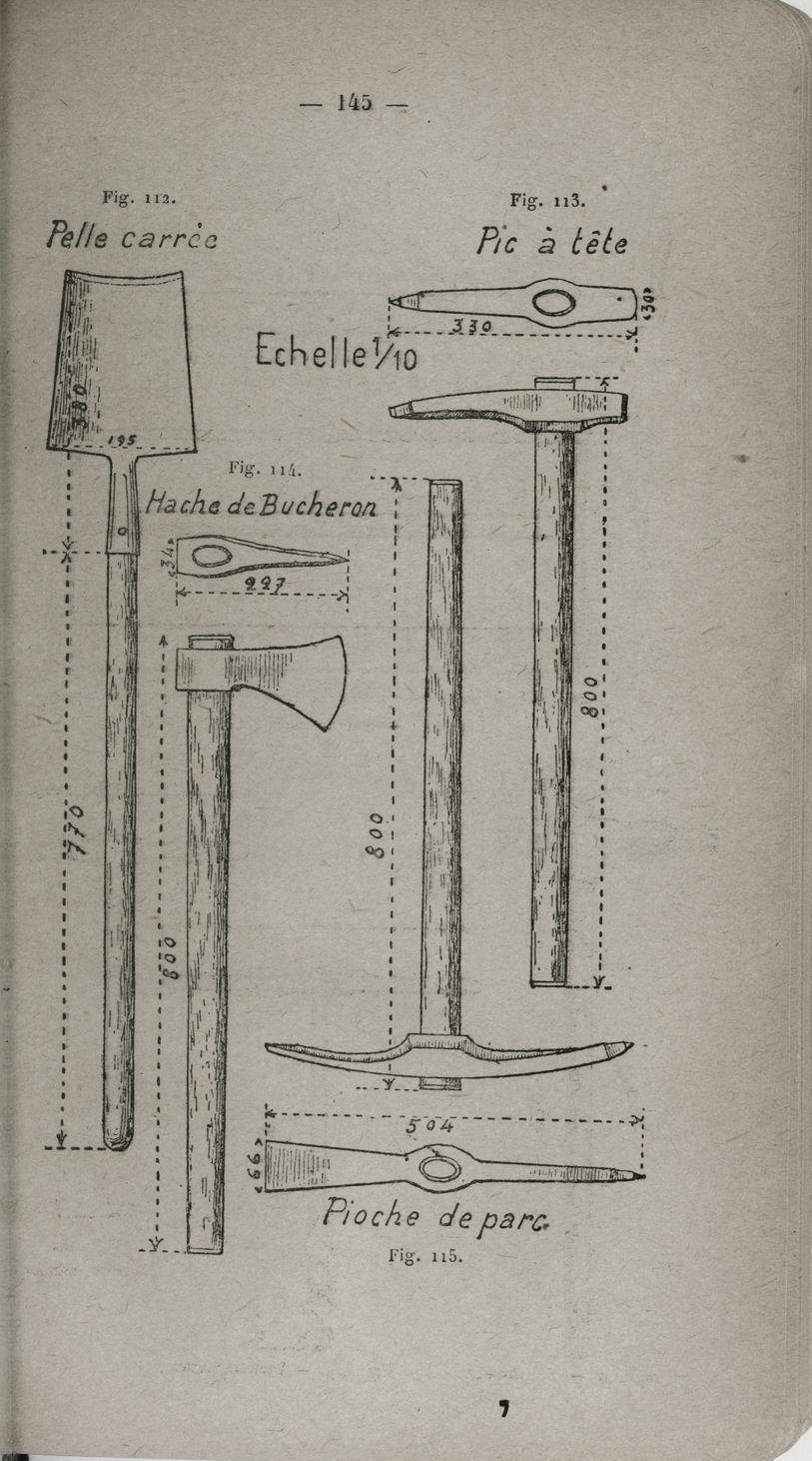
Sources:
Grand Quartier Général - 3e Bureau. Manuel du Chef de Section d'Infanterie Imprimerie Nationale, Paris: ed. January 1916.
Grand Quartier Général - 3e Bureau. Instruction sur les travaux de campagne à l'usage des troupes de toutes armes Imprimerie Nationale, Paris: 21 December 1915.
Bernard, Gilles and Gérard Lachaux. L'Equipement du Poilu. Hors-Série No. 19. Paris: 2008.
Mirouze, Laurent and Stéphane Dekerle. The French Army in the First World War 1914-1918 (vol. 2). Verlag Militaria: Vienna, 2008.


 Pelle ronde ("round shovel") M1916 with case. In principle, the case was reserved for shovels distributed in the engineers and was not distributed to infantry. Aside from being distributed with a shorter handle (45 cm in length), the M1916 was identical to the pre-war
Pelle ronde ("round shovel") M1916 with case. In principle, the case was reserved for shovels distributed in the engineers and was not distributed to infantry. Aside from being distributed with a shorter handle (45 cm in length), the M1916 was identical to the pre-war  Serpe with case. The billhook was one of the only portable tools that could not be carried on the belt. The billhook was not pushed by authorities to be used as a weapon, at least not officially at any rate. Variants of cases were produced during the war.
Serpe with case. The billhook was one of the only portable tools that could not be carried on the belt. The billhook was not pushed by authorities to be used as a weapon, at least not officially at any rate. Variants of cases were produced during the war. The cisailles M1905 with a war-time production leather case and an ersatz canvas pouch. The small size and light design of the M1905 quickly proved insufficient in the environment of trench warfare.
The cisailles M1905 with a war-time production leather case and an ersatz canvas pouch. The small size and light design of the M1905 quickly proved insufficient in the environment of trench warfare. Top and bottom left: hache à main with case. At right: hache portative distributed to engineers was occasionally found in the infantry as well. In principle, for transport the handle is separated from the blade.
Top and bottom left: hache à main with case. At right: hache portative distributed to engineers was occasionally found in the infantry as well. In principle, for transport the handle is separated from the blade.









